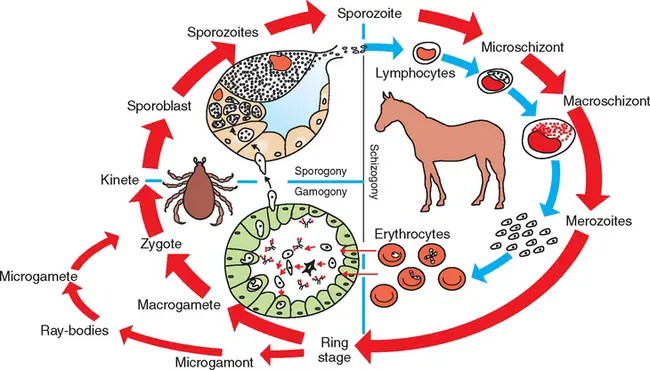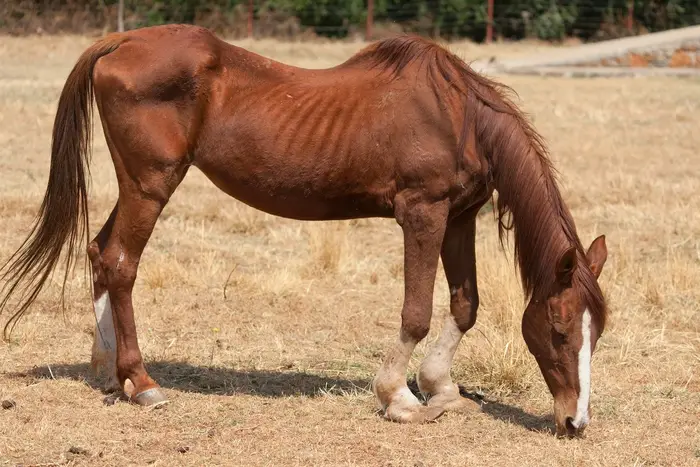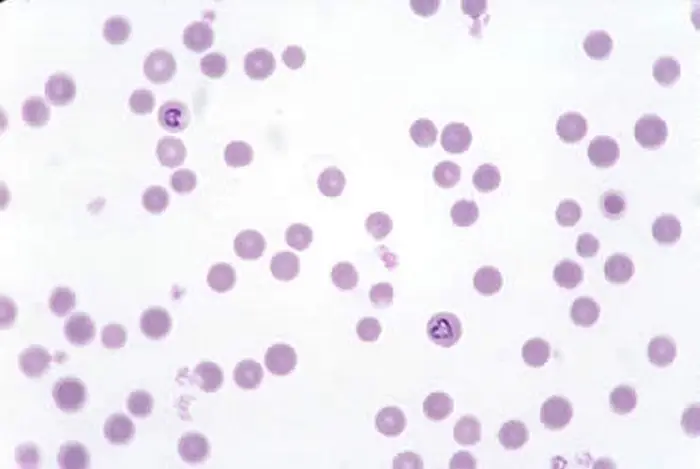Equine piroplasmosis is the most common protozoan disease of horses. The protozoan genus Babesia is a member of the Piroplasmida, a constituent group of the Apicomplexa. When a tick intermediate host ingests infected blood, the parasite babesia enters the gut epithelium and multiply by schizogony, forming organisms known as vermicules. In the vertebrae host, they form intraerythrocytic pyriform, round or oval bodies which multiply by budding.
Causes of Equine Piroplasmosis
Equine piroplasma is caused by two species of haemprotozoan, piroplasma Babesia equi and Babesia caballi. The organism occurs in the erythrocyte of horse, donkey, mule, and zebra. The babesia merozoite invades the red blood cell of the hosts and transforms into trophozoites which grow and divides. B equi trophozoites appear as round, oval, elliptical, or spindle structures, measuring 1.0-3.0 micrometer in diameter. B caballi is a relatively larger species with pyriform stages measuring 2.5-4.0 micrometer in length.

Transmission of Equine Babesiosis
The horses acquire the Babesia organism when parasitized with Ixidid tick harboring sporozoite in their salivary secretions. The organism is transmitted by various genera of ticks like Dermacentor spp, Rhipicephalus spp, and Hyalomma spp. B caballi persist through several generations in Dermacentor spp.

Epidemiology of Equine Piroplasmosis
The epidemiology of babesiosis is also known as piroplasmosis. The incidence of equine babesiosis is closely related to the tick species, geographical distribution, and the seasonal activity responsible for its transmission. B caballi is found in Asia, Africa, America, Southern Europe, and Russia. B equi is prevalent worldwide, including in South Asian countries.
In areas with high transmission rates, the immune status of the horse population is maintained at a high level, and the incidence of the disease is low. The disease will, however, be inevitable in animals introduced from a non-infected region. A zone of endemic instability occurs if the number of infected ticks is insufficient. It ensures immunity in a high proportion of the animals at risk. In these circumstances, babesiosis will occur sporadically at the time of year when ticks are active. A new endemic focus is likely to be formed when an infected horse is moved into a locality with a “clean” tick population.
Pathogenesis of Babesiosis in Horses
B equi is more pathogenic than B caballi. An incubation period of 6-7 days and 10-21 days has been recorded for B caballi and B equi infections, respectively. The exact mechanism of pathogenesis in equine babesiosis is not entirely known; still, sludging of blood in capillaries of various organs is mainly responsible for pathogenesis in peracute infections.
In acute infection, there is large-scale destruction of erythrocytes resulting in anemia. In addition, intravascular hemolysis, indiscriminate phagocytosis of infected or non-infected erythrocytes by activated macrophage system also contribute to anemia in babesiosis—intravascular hemolysis results in marked hyperbilirubinemia and jaundice. There is leukocytosis with neutrophilia.

Clinical Signs of Equine Piroplasmosis
Equine babesiosis can occur in acute, subacute, and chronic forms. The peracute form of the disease is rare in which the animals die within 24 hours of the onset of clinical signs. The significant symptoms with B caballi are:
- High fever 106°F.
- Anemia.
- Icterus or jaundice.
- Highly colored urine (hemoglobinuria).
- Gastroenteritis.
- Paralysis of hindquarters.
Hemoglobinuria is more common in infection with B equi. The animal exhibits colicy symptoms, pawing, high fever, incoordinate gait, and circling movements.
- There are reports of the cerebral form of babesiosis in equines.
- The animals show edema of dependent parts like fetlock and ventral aspects of the abdomen.
- Pathecheal hemorrhages on the mucous membranes of nostrils and nictitating membranes.
- The animal may pass hard feces covered with yellow mucous.
- Pregnant mares may abort.
Diagnosis of Equine Babesiosis
The standard diagnostic procedures are as follows:
- Diagnosis of Babesiosis in horses is based on the history of the prevalence of ticks, clinical signs, and identification of the babesia organism in the blood smear.
- Hematological values like reduced hemoglobin and TEC and increased ESR help in diagnosis.
- There is a fall in blood platelet count and fibrinogen content in the blood.
- Serological tests like CFT and ELISA are also applied for the diagnosis of Equine Babesiosis.
- However, more sensitive and rapid PCR methods have also been developed for detecting B equi and B caballi infection, especially when routine smears and serological tests fail to do so.

Treatment and Control Equine Piroplasmosis
The treatment strategies of Equine Babesiosis are:
- Imidocarb 2mg per kg body weight intramuscularly twice at 24 hours intervals is effective against B caballi infection.
- However, a dose of 4mg per kg body weight four times at 72 hours intervals is effective against B equi.
- Antiheilerial drug-like Buparvaquone 5-6 mg per kg bodyweight parenteral can be administered for treating B equi infection.
- Diamenazine aceturate 3.5 mg per kg body weight injected deep intramuscularly can eliminate B caballi infection.
Concluding Remarks on Equine Piroplasmosis
Piroplasmosis is a global problem in the equine population. The disease is spread and transmitted by tick vectors. The control of the ticks population is the primary strategy to control this in horses. Ticks control can be achieved by destroying tick vectors using acaricidal drugs. Iatrogenic transfer of infected blood using contaminated needles and surgical instruments should be avoided. Strict quarantine measures must be maintained in the horse stables.